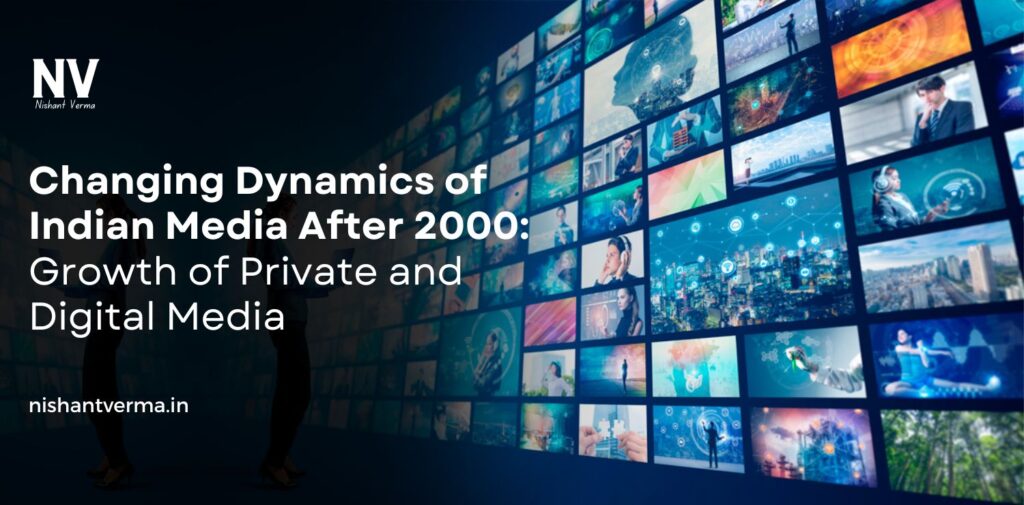The Indian media landscape has seen a dramatic shift since the turn of the 21st century. From the dominance of state-run media to the rise of private television channels, radio stations, and digital platforms, the media in India has transformed in many ways. The growth of private and digital media has redefined how news, entertainment, and information are delivered to the Indian audience. In this article, we will explore the changes in the Indian media landscape post-2000 and how these developments have affected the way people consume information.
The Shift from State to Private Media
Before the year 2000, the Indian media scene was largely controlled by the government. The state-run All India Radio (AIR) and Doordarshan were the primary sources of news and entertainment for millions of Indians. These government-owned platforms played an essential role in shaping public opinion and providing information. However, with liberalization and economic reforms in the 1990s, India saw the beginning of a media revolution that gained momentum in the new millennium.
In the years following 2000, private media channels began to dominate the landscape. The entry of private news channels like NDTV, Zee News, and CNN-IBN transformed how news was reported and consumed. The introduction of 24-hour news channels allowed Indian viewers to access information in real-time. This shift from a government-controlled to a private media environment gave rise to diverse viewpoints, breaking away from the monotony of state-sponsored reporting.
The growth of private media also brought more competition to the industry. As media companies competed for viewership and advertisement revenues, they started diversifying content to cater to various audience segments. This shift made media more accessible, and for the first time, the Indian audience had a wide range of choices in news and entertainment.
The Role of Satellite Television in Expanding Reach
One of the major factors driving the growth of private media was the expansion of satellite television. In the 1990s, cable and satellite TV reached urban areas, but it was after 2000 that the reach expanded to rural India as well. As cable TV networks proliferated, satellite television became the dominant medium for entertainment and news. Regional channels flourished, making television content more accessible to people across the country in their own languages.
Channels like Star Plus, Zee TV, and Sony Entertainment Television became household names, while regional networks like Sun TV, ETV, and Doordarshan’s regional channels saw a surge in popularity. This growth led to the creation of a more inclusive media ecosystem that catered to India’s diverse linguistic, cultural, and regional needs.
The spread of satellite television also helped make India’s media more global. International media organizations, such as BBC, CNN, and Al Jazeera, started offering services in India, bringing global news to Indian audiences. This exposure to international media gave Indians a broader perspective on global affairs and connected them to the world beyond their borders.

Digital Media: The New Frontier
The most significant change in the Indian media landscape since 2000 has been the rise of digital media. With the rapid growth of the internet and mobile technology, digital platforms have emerged as a dominant force in how Indians consume media. India’s internet user base has grown exponentially, and mobile phones have become the primary device for accessing news, entertainment, and social media.
The growth of social media platforms like Facebook, Twitter, Instagram, and YouTube has changed how people engage with content. The rise of digital media has democratized information dissemination, with users themselves becoming content creators. Platforms like YouTube and Instagram have allowed individuals to create their own channels and build massive audiences. Many influencers, bloggers, and vloggers have now become the new faces of Indian media.
Social media also plays an important role in shaping public opinion and bringing attention to various social and political issues. Activism, both political and social, has flourished on digital platforms, with hashtags and viral trends often sparking national debates. Movements like #MeToo and #JusticeForAsifa gained traction primarily through social media, showing the power of digital media in mobilizing people.
Moreover, the shift to digital content has given rise to streaming services like Netflix, Amazon Prime Video, and Hotstar, which offer on-demand content to users. This has revolutionized how people consume entertainment, giving them the freedom to watch movies, TV shows, and documentaries at their convenience. The growth of OTT (Over-The-Top) platforms has also given rise to original Indian web series, which have garnered international recognition.
Changing News Consumption Patterns
With the rise of private and digital media, the way Indians consume news has undergone a significant transformation. Traditionally, news was consumed through newspapers, radio, and television. While newspapers are still widely read, digital platforms have become the primary source of news for many Indians. Mobile phones and laptops have replaced traditional forms of media, allowing users to access news instantly from anywhere.
The rise of news apps like Flipboard, Inshorts, and News18 has made it easier for people to stay updated with the latest headlines. These apps deliver short and concise news summaries, catering to the fast-paced lifestyles of today’s readers. Social media also plays a major role in news dissemination. Platforms like Twitter and Facebook are often the first places where breaking news is reported, and they allow users to engage in conversations around those events.
This shift towards digital news has also led to the rise of online news websites and digital-only media organizations. Websites like The Wire, Scroll.in, and Firstpost have gained a substantial following by providing in-depth analysis and alternative perspectives to mainstream media coverage. Digital news platforms often provide more detailed stories, investigative reports, and opinion pieces, giving people access to a more diverse range of viewpoints.
However, the rise of digital news has also brought challenges. The spread of misinformation and fake news has become a major concern, particularly on social media. The speed at which information circulates online often leads to the spread of unverified news, creating confusion and panic. Fact-checking websites and news organizations are now working to combat this issue, but misinformation remains a significant problem in the digital media landscape.

The Challenges of Media Ownership and Ethical Concerns
As the media landscape has evolved, new challenges have arisen, particularly around media ownership and ethical concerns. A few large corporate houses now own many of the leading media channels and newspapers, which has raised concerns about biased reporting and conflicts of interest. There are growing fears that media outlets are being influenced by political or corporate interests, leading to a lack of journalistic integrity and objectivity in news reporting.
Moreover, sensationalism and the rise of “clickbait” journalism have become widespread in the race for higher viewership and ad revenues. Some television channels and online news platforms prioritize sensational stories to attract viewers, sometimes at the cost of factual accuracy. This trend is harmful as it distracts from important issues and can mislead the public.
The growing influence of social media has also led to ethical concerns. The spread of harmful content, hate speech, and online harassment is rampant on social media platforms. While these platforms have made strides in regulating content, the challenge of balancing free speech with responsible usage remains a contentious issue.

The Future of Indian Media: Challenges and Opportunities
The future of Indian media is bound to be shaped by the ongoing technological advancements and the changing needs of the audience. The growth of 5G technology and the increasing availability of high-speed internet will further accelerate the shift towards digital media. This will open up more opportunities for innovation, particularly in terms of interactive and immersive content, such as virtual reality (VR) and augmented reality (AR).
However, the challenges faced by the media industry—such as ownership issues, fake news, and ethical concerns—will continue to need attention. Media organizations will have to adapt to changing technologies, new consumption patterns, and a more informed and demanding audience. Journalistic standards will need to be upheld, ensuring that the media remains a reliable source of information in an increasingly complex and fast-paced world.
Conclusion
Since the turn of the century, Indian media has undergone an impressive transformation, moving from state-run platforms to a thriving ecosystem of private and digital media. The rise of satellite television and the explosion of digital platforms have changed how people access news, entertainment, and information. Despite challenges such as fake news, media ownership, and ethical concerns, Indian media continues to evolve and play a pivotal role in shaping public discourse. As the media landscape continues to grow, it will be exciting to see how it adapts to new technologies and changes in audience behavior, ultimately providing even more diverse and engaging content to the people of India.




